Compo Picture Frame
Object
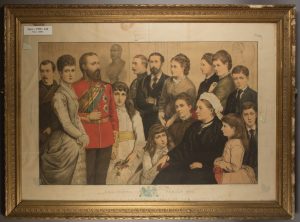
The object is a wooden frame surrounding a paper print which is part of the collections at Beamish Museum. The frame has gold-coloured floral ornamentation, showing stylised fleur-de-lis and a raised laurel edge. The print is a copy of a painting by James Archer (1822 – 1904), showing the Royal family in 1880.
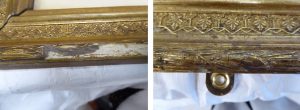
The frame decoration is made of composite or ‘compo’: a moulding material usually consisting of Gilder’s whiting (chalk powder), glue, oil and rosin. Compo was invented in the late 18th century as a cheaper and less time-consuming alternative to carved wooden decoration. The material can be easily moulded by pushing heated compo putty into a mould. As compo cools, it solidifies to a very hard consistency that is adhered to the frame with a resin or glue. For gilded surfaces, the compo is covered in gesso – a chalky layer that creates the smooth white surface – and a darkened bole that is gilded with gold leaf (Rogers 1991, 10). The object in question has not been gilded, but instead painted with a dark undertone and a brass paint; copper and zinc were detected using portable X-Ray Fluorescence.

The wooden components are softwood, likely pine. It consists of four separate pieces joined together with a mitre join, fastened with iron nails on both sides of each join. The glass is clear and has a few elongated bubbles trapped inside, vertically oriented, caused by its 20th century manufacturing method.
Condition
- Frame joins have slightly separated, likely due to warping
- Evidence of dust and dirt on the surface and between the joins
- Some tarnishing to the brass paint
- The paint has chipped in several areas
- Areas of missing compo decoration
- Evidence of cracking on the compo decoration
- Several areas of detached compo decoration
- Signs of old tape and adhesive residue on the glass.
Conservation
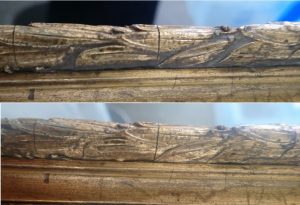
To disassemble the frame, the parcel tape was removed from the wood and card. Using a cotton swab and ethanol on the edges, the adhesive was dissolved and the tape was gently pulled off with tweezers. The adhesive residues on the wood were then also removed by with ethanol swabbing. The cardboard was held to the frame with small diamond shaped metal pins, but was easily manoeuvred out, as it was slightly smaller than the frame’s opening. The card, tissue paper print and glass were taken out and laid out separately, covering the print to limit light exposure.
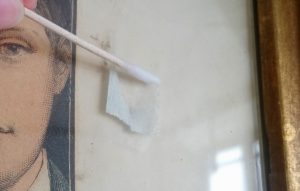
All separate components were initially cleaned using a museum vacuum with a High Efficiency Particle Air filtration system to avoid cross contamination, at a low to medium suction. The nozzle was covered with a fine mesh to catch large dirt fragments and to avoid losing any loose original material. Following this, the compo decoration and glass were cleaned.
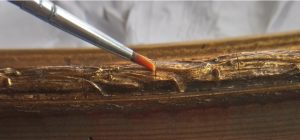
The surface of the compo decoration was cleaned using cotton wool swabs with deionised water as this caused the least amount of damage to the decorative paint compared to other solvents.
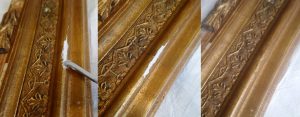
The adhesive and tape residue on the glass was removed using ethanol as it removed all residue and didn’t adversely affect the glass. The remaining areas of glass were then surface cleaned using ethanol in order to remove any dust or dirt from the surface.
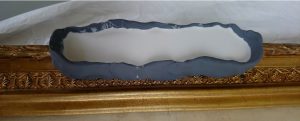
The many cracks in the raised laurel edge, caused by the compo’s degradation pattern, are areas of weakness in the material and have already resulted in material loss. Strengthening these areas avoids further loss, which is why the cracks were consolidated with a 10% solution of Paraloid B-72 in acetone (w/v).9 It was applied with a soft brush, as small droplets that were pulled into the crack by capillary forces. This was repeated 3 times, to ensure sufficient saturation in the cracks. Excess consolidant was then carefully removed using an acetone swab.

Small gaps where white gesso or wood were showing, were filled using Flügger, a fine white filler paste. The paste was applied with a dental tool, left to harden and smoothed down with a cotton swab slightly dampened with deionised water. The surface was then retouched using Liquitex acrylic paint; the first layer
gave a dark brown undertone to mimic the bole and tarnished brass surface, covered with a thin layer of iridescent gold-coloured paint.
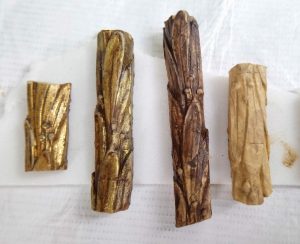
The larger gaps in the laurel edge were filled by casting and carving individual pieces and adhering them to the frame. To imitate the detailed decoration, a silicone mould was made from an intact area of the laurel edge using silicon rubber. Although the decoration on the frame was originally made from compo (water, rabbit skin glue, hide glue, linseed oil, crushed rosin, gilder’s whiting) it was decided that an alternative material would be used to cast the decorative fills as these would make the replica areas distinguishable from the original. A variety of materials were tested for their ability to capture detail, their carvability, ease of use, and durability. An epoxy resin mixed with glass micro balloons was found to be the most successful and was used to cast the missing areas of decoration.
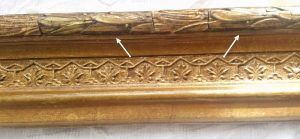
The fills were then painted with Acrylics, first with the grey-beige compo colour, then with alternating layers of dark brown and iridescent gold. The result was a convincing replica of the compo decoration, which could be distinguished from the original using UV-light. Exposed areas of compo and wood were coated with a 10% solution of Paraloid B-72 in acetone, to create a stable barrier between the original material and the epoxy fills. The fills were then adhered to the frame using 40% Paraloid B-72 in acetone (w/v). The pieces of the frame that were already detached were re-adhered back into their original positions as well.

After finalising the treatment on the frame, the components were reassembled. To protect the untreated print from further damage, a window mount was made from cream-coloured acid-free conservation grade card. This provided a barrier between the paper and glass. The backing card was replaced and the metal pins were manouvered to hold everything in place. Framers tape was then applied to the back in order to help keep everything in place and improve aesthetics.
